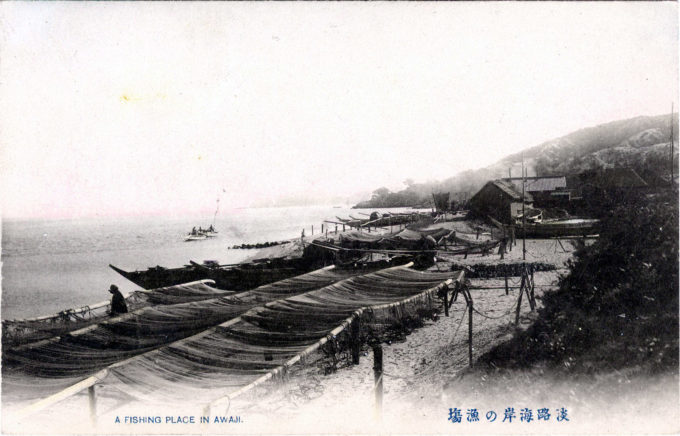
“A fishing place in Awaji”, Hyogo Prefecture, c. 1920. (The Japanese caption translates to “The shore and sea of the fishing grounds.”) According to the Shinto creation myth Awaji was the first of the ōyashima islands [the eight islands that constitute Japan] born by the two kami, Izanagi and Izanami who gave earth its solid form. Awaji constituted its own province between the 7th-19th centuries. After the Restoration, Awaji was incorporated into Hyogo Prefecture of the Kansai region. In the present day, Awaji island is connected to Honshū island by the Akashi Kaikyō Bridge, the longest suspension bridge in the world.
“Both designers and antique-textile enthusiasts will surely be impressed by Japanese fishermen’s coats from Awaji Island, antique quilted coats in deep blue with white stitching … They were made in the late 19th and early 20th centuries in five fishing villages on Awaji, which is at the eastern end of the Inland Sea.
“… The quilted coats were originally a necessity to keep fishermen warm and dry at sea in the days of sail and oar. Over time they evolved into ceremonial robes for festivals or when fishermen assumed positions of authority. In the 1920’s, when the fishermen put engines in their boats and adopted Western clothing, the coats went out of fashion and out of use. Because most were eventually discarded, the ones that were saved are especially prized today.
“They are called sashiko no donza in Japanese. Sashiko is a kind of needlework practiced in Japan (sashi means stitch, and ko means small) and donza is a fisherman’s coat. Their fabricators use a running stitch to make complex geometric patterns and stripes on layers of fabric. The densely spaced stitches made the cloth thicker and warmer and provided a way to reuse old fabric, just as Americans do in patchwork quilts.
“The coats, which required great skill, took months to sew. They were often made by the fishermen’s grandmothers, mothers or wives. Though no one knows exactly when the Japanese began making the coats, they were used widely as early as the late Edo period, which ended in 1867. Awaji, the largest of some 300 islands in Japan’s Inland Sea, was then very prosperous, a major source of fresh octopus, fish and farm products for nearby Kobe and Osaka.
“Not that the fishermen themselves were ever wealthy. In the traditional order of society in Japan, everyone has an inherited status, with the samurai at the top and the common people at the bottom. Commoners were categorized according to their hereditary occupations: farmer, craftsman, merchant or fisherman. Not every fisherman had sashiko no donza, but only fishermen were permitted to wear them.
– “The Mystique of Japan’s Fishing Coats”, by Wendy Moonan, New York Times, May 11, 2001


Pingback: “Fishing boat”, c. 1910. | Old TokyoOld Tokyo
Pingback: “Dried bonito dealer”, c. 1920. | Old Tokyo